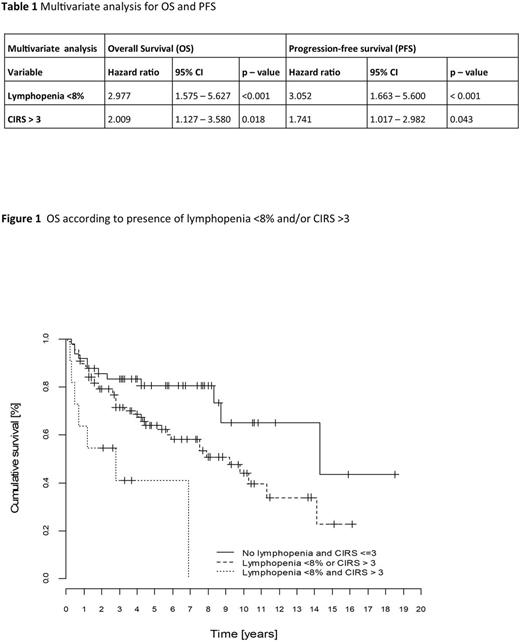Abstract
Introduction: The proportion of elderly Hodgkin lymphoma (HL) patients (age ≥ 60 years) ranges between 15% and 35%. Outcome of this group of patients (pts) is significantly inferior compared with younger pts. Management of therapy is still unclear, standard treatment is not yet defined, especially with concomitant cardiac and/or pulmonary diseases. Purpose of this study was to analyze treatment and outcome of elderly HL pts prospectively registered in Hodgkin Lymphoma Project in the Czech Republic.
Patients and methods: The proportion of elderly patients in the Czech HL Registry was 11%. We analyzed 151 pts ≥ 60 years (y) with classical HL diagnosed between 1995 and 2016. Median age was 67y (60-84), 72.2% of them were 60-70y old and male gender represented 54% (82 pts). Histological subtype mixed cellularity occured most frequently (50%). Advanced clinical stage (CS) was confirmed in 67.3% pts. CS in 1 pt remained unknown. Chemotherapy (CT) alone was used in 103 (68.2%) of pts (initial/intermediate stages 15 pts, advanced stages 87 pts, CS unknown 1 pt). Combined modality of treatment (CT and radiotherapy, RT) was used in 42 pts (intial/intermediate stages 30 pts, advanced stages 12 pts). Anthracycline - based CT received 81.5 % of pts (119 pts). Three pts (2%) were treated with RT alone, 2 pts (1.3%) with CT+ other treatment and 1 pt was without treatment after surgery exstirpation.
Results: The median follow-up was 4.2 years. Treatment response was evaluable in 138 (91.4%) pts. Overall response rate (CR+PR) after the first-line treatment was observed in 125 (82.8%) pts, with 99 (65.7%) CR. Stable disease was observed in 1 (0.7%) pt and primary disease progression in 12 (7.9%) of pts. Relapses occured in 10% and 1 pt underwent high dose CT and autologous stem cell transplantation in the 1st relapse (age 61y). Median PFS and OS was 8.7y and 10.3y, respectively. Four - year PFS and OS was 69.5% and 71.6%, respectively. Overall 59.6% pts are alive and 61 (40.4%) of pts died: HL progression 17 pts, toxicity of treatment 15 pts, secondary malignancy 8 pts, others causes 12 pts. The cause of death in 9 pts remained unknown.
Univariate Cox regression analysis identifies age ≥ 75y (p=0.033), failure of CR achievement (p<0.001), no anthracycline based CT (p=0.018), low albumin level < 4.0g/dl (p=0.016), lymphopenia <8% (p=0.006), CIRS score > 3 (p=0.037) as risk factors for OS. All mentioned factors without CIRS score predicted a significantly shorter PFS. CIRS > 3 and lymphopenia <8% were independent factors for shorter OS and PFS in multivariate analysis (Table 1, Figure 1).
Conclusions. Long-term survival of our pts depended on the CIRS score and lymphopenia. Interestingly, 4 IPS factors (sex, hemoglobin, leucocytes, GHSG advanced stage), ADL (activity of daily living) and performance status WHO/ECOG were not significant for survival in univariate analysis. Prospective clinical studies are still needed to determine an optimal effective regimen with low toxicity in elderly pts.
This work was supported by grant awarded by AZV 16-29857A, Ministry of Health in Czech Republic and Research project P 27/2012 awarded by Charles University in Prague, Third Faculty of Medicine, Prague, Czech Republic
Belada: Roche: Consultancy, Honoraria, Membership on an entity's Board of Directors or advisory committees, Other: Travel grants , Research Funding, Speakers Bureau; Gilead: Consultancy, Honoraria, Membership on an entity's Board of Directors or advisory committees, Other: Travel grants , Speakers Bureau; Janssen: Consultancy, Honoraria, Membership on an entity's Board of Directors or advisory committees, Other: Travel grants , Speakers Bureau; AbbVie: Consultancy, Honoraria, Membership on an entity's Board of Directors or advisory committees, Other: Travel grants, Speakers Bureau.
Author notes
Asterisk with author names denotes non-ASH members.


This feature is available to Subscribers Only
Sign In or Create an Account Close Modal